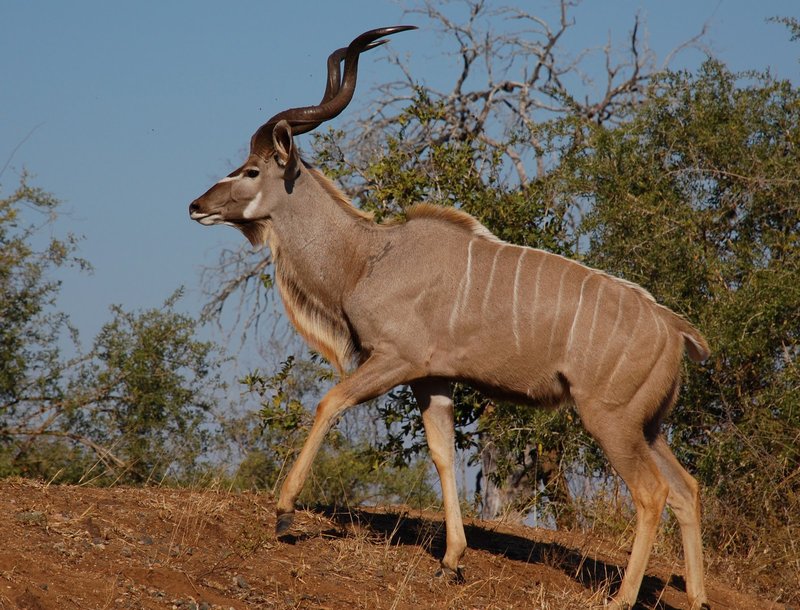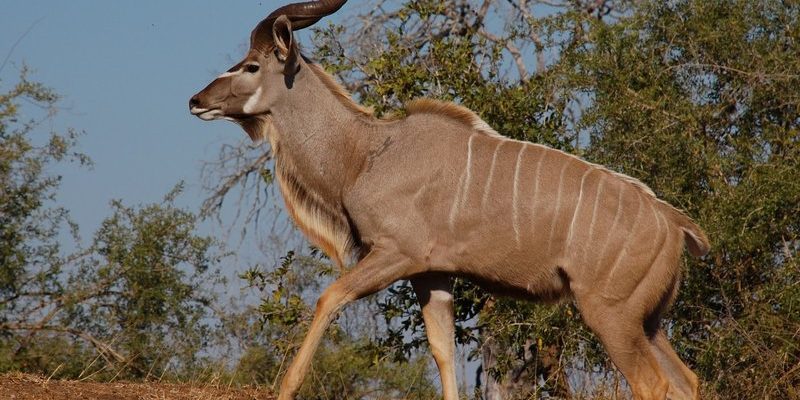
In this guide, I’m going to walk you through ten animals that resemble the kudu. Think of it like a party where all the guests have a similar style but distinct personalities. By the end, you’ll have a good understanding of what sets each of these animals apart, and you might even impress your friends with your newfound knowledge!
1. Nyala
If the kudu is the graceful dancer, then the nyala is like the charming storyteller who captivates everyone’s attention. Both animals belong to the same family, Bovidae, and could easily be mistaken for one another at first glance. One of the most noticeable differences is in their size. The nyala is typically smaller than the kudu, with males weighing around 100–125 pounds and standing about 35–40 inches at the shoulder.
Colors are also a giveaway. Male nyalas have spiral horns and a rich chestnut brown coat with white markings. In contrast, male kudus are a little larger and grayish-brown. If you see an animal with shaggy fur and a twisted horn peeking out, take a closer look. You might just spot a nyala instead of a kudu!
2. Eland
Now, let’s talk about the eland. Imagine the kudu’s bigger, more robust cousin. Elands are the largest of the antelope species and can weigh up to 2,200 pounds—double that of a kudu! They have thick, spiral horns and a more barrel-shaped body, giving them a sturdy look.
What’s interesting about elands is their social nature. They often gather in large herds, unlike kudus, which prefer to be solitary or in small groups. If you see a massive antelope munching grass in a large crowd, chances are it’s an eland, not a kudu.
3. Bushbuck
If the kudu is a graceful dancer and the nyala is a charming storyteller, think of the bushbuck as the shy observer at the party. Bushbucks are smaller and more elusive. Males weigh around 100 pounds and have short, twisted horns, but they don’t achieve the striking height or long horns of the kudu.
One way to tell them apart is their habitat preferences. Bushbucks are more likely to hang out in dense thickets and wooded areas, where their coat blends beautifully with the surroundings. So, while and kudus tend to roam open grasslands, look for bushbucks where the shadows reign.
4. Impala
The impala is like the lively entertainer at our animal gathering—always on the move and full of energy. Similar to kudus, they have elegant bodies and long legs, but here’s the thing: impalas are much smaller, typically weighing around 75–100 pounds.
You might notice their distinctive black “M” marking on their rumps and their incredible jumping ability. If you see an animal leaping gracefully through the air, it’s likely an impala showing off its acrobatic skills. Interestingly, while both species can be found in savannahs, kudus prefer thicker bush areas compared to the open habitats favored by impalas.
5. Greater kudu vs. Lesser kudu
This one might sound a bit tricky, but you can think of the lesser kudu as the younger sibling trying to keep up with the greater kudu. Both belong to the same genus, but the greater kudu is larger, reaching heights of around 4–6 feet at the shoulder, while the lesser kudu stands at about 3–4 feet.
Check out their horns too! The greater kudu’s horns are longer and have a more pronounced spiral, while the lesser kudu’s horns are thinner and less twisted. Plus, their color palette varies: the greater kudu is often grayish-brown, while the lesser kudu sports a more reddish-brown hue with striking white stripes.
6. Sitatunga
Imagine a deer that’s also an excellent swimmer. That’s the sitatunga for you! These semi-aquatic antelopes are often found in marshy areas, which sets them apart from the more terrestrial kudus.
Sitatunga have long, splayed hooves that help them walk on soft, muddy ground, while kudus are built for solid terrain. The males have long, spiral horns similar to the kudu, but their coats are often more shaggy and have a lighter, more grayish-brown hue. If you encounter a sleek, gazelle-like creature navigating through water plants, you might just be looking at a sitatunga.
7. Waterbuck
Waterbucks are another aquatic cousin of the kudu, but they tend to be bulkier and have a more pronounced body. Males can weigh anywhere from 400 to 600 pounds and have a distinctive white ring on their rear—something you won’t find on a kudu.
While kudus have a more elegant build, waterbucks are rounder and stockier. Both animals have similar habitats but waterbucks are more grounded in areas close to water bodies. If you see a hefty antelope lounging near a lake, chances are it’s a waterbuck and not a kudu.
8. Bongo
If you’re looking for vibrant colors and striking patterns, the bongo steals the show! These animals, often found in the rainforests of Africa, are known for their beautiful reddish-brown coats and spiral horns. They remind me of artful decorations, almost as if someone painted them perfectly for a grand display.
Although similar in height to kudus, bongos are stockier and have more extensive white stripes running down their bodies. They are also more reclusive, prefering dense forests. If you see an antelope with bold stripes and a rich coat hiding among the trees, take a moment to appreciate the uniqueness of the bongo!
9. Duiker
Duikers are the tiny, shy cousins of the kudu, and they are quite different in size and demeanor. Most duikers are around 30–40 inches tall and weigh just about 50–100 pounds. They might be small, but they’re quick movers, often darting between bushes to avoid predators.
Their coat is usually a grayish-brown, similar to the kudu, but they lack the impressive horns. If you spot a petite antelope darting quickly through the underbrush, don’t confuse it with a kudu; it’s likely a duiker trying to hide!
10. Gazelles
Finally, let’s wrap up our party with the elegant gazelles. These animals are known for their speed and grace, and while they share certain features with kudus, they’re generally lighter and more built for running.
Gazelles have long legs and a lean body that allow them to dodge predators with ease. They also sport different color patterns and tend to have smaller horns. If you see a herd of nimble animals racing across the plains, you can bet you’ve spotted gazelles—not kudus!
In conclusion, while the kudu stands out with its unique charm and elegance, the animal kingdom is filled with look-alikes. Understanding the key differences can enhance your knowledge of these fantastic creatures and make wildlife spotting an even more enjoyable experience. So next time you’re out in nature, keep an eye out for these other antelopes, and you might just discover a fascinating new favorite!

